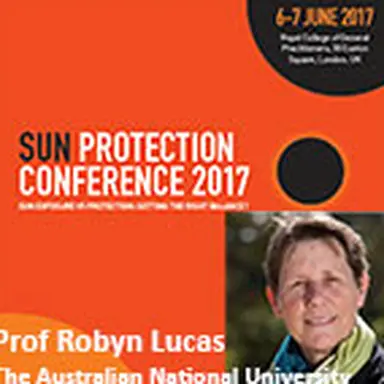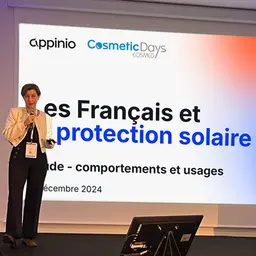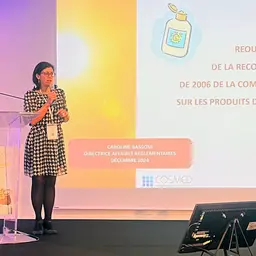
Attention is often drawn to the harmful effects of the sun’s UV rays on the skin and health. At the Sun Protection Conference held in London on June 6-7, 2017, Professor Robyn Lucas, epidemiologist at the Australian National University (ANU), highlighted the other, more beneficial side of sun exposure, pleading for a better balance between shade and sun to keep healthy. In addition, she recommended adjusting the prevention messages issued to the public.
First, Professor Robyn Lucas dedicated her research to the negative impacts of the sun’s UV rays. But it gradually led her to also consider the benefits of sun exposure for human health. How can we enjoy the best the sun has to offer, while avoiding the worst? That is what her presentation focused on, as an opening to the conference.
To her, ‘sun’ does not only rhyme with ‘protection’… During her daily activities, she contributes to drafting prevention messages intended for the public, and she admits that right now, they are not satisfactory enough: ‘We need to improve,’ she says, ‘and find a better balance between natural exposure to the sun, to optimize our health, and the risks of overexposure, bearing in mind that we do not all have the same balance.’
The Yin and the Yang of sun exposure
Sun exposure is a factor of wellness, she reiterated: who does not like the gentle warmth of sun rays caressing their faces… provided they do not get sunburnt?
However, solar radiation is not only composed of UVBs, which are mainly responsible for sunburns. Scientists have also taken interest in UVAs for about twenty years: they are those involved in the formation of melanoma and the increase in the number of skin cancers. Today, we are starting to consider the effects of visible light or infrared rays, which also have effects on our health.
The dark side of the sun
Australia is particularly affected by the development of melanomas, and it is even the most frequent cancer in this country. These statistics can be explained by an extremely sunny environment in which a majority of white-skinned people live, meaning they are naturally poorly protected against the harmful effects of solar radiation. The good news is, the incidence of melanoma is declining among young generations, as a result of the prevention policies implemented throughout the country.
Nevertheless, among the damages caused by solar radiation, Professor Robyn Lucas also mentioned skin aging, eye ailments (cataract, pterygium – a tissue excrescence on the eye’s crystalline lens –, cancer, photo-conjunctivitis, and photo-keratitis), as well as immunosuppression phenomena involving higher sensitivity to viral infections and weaker immune responses, which can affect vaccine efficacy, among others…
The bright side of UV rays
However, of course, the other aspect of sun exposure is the production of vitamin D, which is absolutely essential to health, and whose main source is actually skin exposure to UVBs. Many diseases are associated with a low level of vitamin D, Robyn Lucas reiterated: for example, many bone diseases like typical rickets, but it was also demonstrated that the risk of breast cancer increases in case of a lack of vitamin D. The thing is, according to the Professor, ‘supplementation in vitamin D has not been shown to be efficient, except in the treatment of rickets.’
But beware, the specialist emphasized, there is more than just vitamin D: other molecules induced by UV rays also play an important role in the immune and biological response of skin cells, with beneficial effects on health. Even if research on all the mechanisms involved is not that well-advanced yet, skin exposure to UV rays seems crucial. However, to be efficient and generate all its positive effects, it should also be done without any protection, since sunscreen filters prevent UV rays from penetrating the skin… although it can increase the risks of developing melanomas. Are we asked to square the circle here?
How to manage sun exposure
The challenge for Robyn Lucas is for everyone to expose themselves enough to benefit from all the biological mechanisms that guarantee good health, while avoiding overexposure, which triggers sunburns and cancers.
To her, several significant factors should be taken into account.
The key factors in sun exposure
• Exposure model
Non-protected, short, but regular exposures enhance the production of vitamin D, whereas intense exposures over short periods – typically the two weeks spent on the beach in summer, when you are confined indoors the rest of the year – are known to increase the risk of developing a cancer. So, we had better have a short walk without any sunscreen on every day, and not skimp on the SPF at the beach…
• UV radiation
Measured with the UV index – which can be easily consulted with the multiple smartphone applications recently developed –, it varies according to the place (latitude, altitude…), the season and time of exposure: the higher it is, the stronger the radiation. A few health authorities recommend avoiding any non-protected exposure beyond a UV index of 3. To Professor Lucas, that is not really the point: the UV index is calculated according to the erythemal response – sunburns –, but the UVA dose received by the skin when it is low can be just as important as when it is high. So, it is mainly the overall UV dose received that should be taken into account.
• UV dose
It depends on two factors: the UV index and the duration of exposure. For example, 10 minutes of exposure to a UV index of 12 equals 40 minutes of exposure to a UV index of 3. What is really crucial for Robyn Lucas is to receive the right dose of UV rays for an optimum production of vitamin D, without exceeding the harmful threshold that would trigger sunburns and damage to skin cells, due to UVAs.
• Skin surface area exposed
To best take advantage of the benefits of sun exposure for health, it is better to expose a large skin surface area – i.e., a high number of skin cells likely to react to UV rays and trigger the beneficial mechanisms – to a low dose of UV rays than a small area to a strong UV dose.
• Skin protection
Natural pigmentation, use of sunscreen products, clothes… all these factors are likely to reduce the dose of UV rays received by the skin.
The right messages
Professor Robyn Lucas recommends changing the prevention messages issued to the public by taking into account all these factors. Here is what she suggests.
• Take the right dose of sun
The UV dose necessary for the production and maintenance of high enough a level of vitamin D is estimated at 1.3 SED (Standard Erythemal dose), bearing in mind that 1 SED (standard dose for the appearance of a sunburn) = 60 (minutes)/UV index.
Since all skins react differently to the sun, the duration of exposure possible without any sunscreen before getting sunburnt varies from one individual to another. To calculate it, Robyn Lucas suggests a simple equation: [60 (minutes)/UV index] x no. of skin phototype according to the Fitzpatrick classification (from 1 to 6, i.e., from the clearest to darkest skins).
Example: for a phototype II and a UV index of 8, the time of exposure will be of 60/8 = 7.5 minutes x 2 = 15 minutes.
• Protect yourself when needed
If you have to stay outdoors and expose yourself to the sun longer than what you can without any protection, Robyn Lucas recommends protecting your skin before going out, in particular with a sun cream with an SPF in coherence with the high UV index.
• Expose yourself as much as you need to
If, on the contrary, you have to stay outdoors for a shorter period of time, you had better not use any protection and expose the largest skin surface area possible to the sun to maximize the production of vitamin D.
• Always protect your face, neck, and hands
The only exception to the rule is, as Professor Robyn Lucas recommended, using sun protection on these areas every time you go out, as they are always exposed. This piece of advice is based on the clinical studies that show they are also the body parts where skin cancers develop the most frequently.
LW













